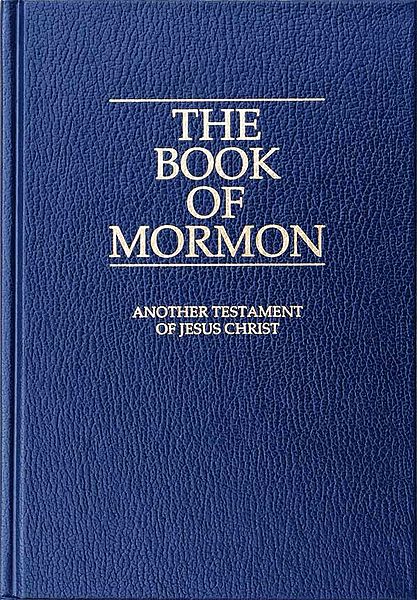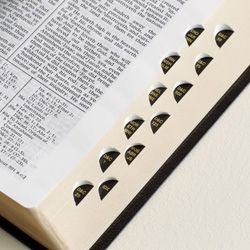Difference between revisions of "LDS Scriptures"
m |
Dennisangot (talk | contribs) |
||
| Line 2: | Line 2: | ||
===[[Book of Mormon]]=== | ===[[Book of Mormon]]=== | ||
| − | The Book of Mormon is similar to the Bible in that it is a compilation of writings from many prophets over many centuries (more than 1,000 years). The Book of Mormon is an account of three groups of people who migrated from Asia to the Americas (the "Jaredites," the "Mulekites," and the family of Lehi). Two of these groups were of Israelite descent. Their descendants lived according to the Law of Moses, but were tutored by their prophets to look forward to the birth and atonement of Christ. Christ visited a remnant of these peoples shortly after His resurrection and established His gospel and [[Priesthood Authority|priesthood authority]] among them. The Book of Mormon’s subtitle is “Another Testament of [[Jesus Christ]].” The book testifies of Christ’s divinity and mission and is another witness that Christ lived, [[Atonement of Jesus Christ|atoned]] for sins, died on the [[Crucifixion of Jesus Christ|cross]], and was [[Resurrection|resurrected]]. The Book of Mormon, unlike the Bible, has only been translated from its original version once (into English—other translations are from the English version), and is therefore considered to have minimal translation errors. | + | [[image: Book of Mormon.jpg|100px|left|alt=The Book of Mormon|The Book of Mormon]]The Book of Mormon is similar to the Bible in that it is a compilation of writings from many prophets over many centuries (more than 1,000 years). The Book of Mormon is an account of three groups of people who migrated from Asia to the Americas (the "Jaredites," the "Mulekites," and the family of Lehi). Two of these groups were of Israelite descent. Their descendants lived according to the Law of Moses, but were tutored by their prophets to look forward to the birth and atonement of Christ. Christ visited a remnant of these peoples shortly after His resurrection and established His gospel and [[Priesthood Authority|priesthood authority]] among them. The Book of Mormon’s subtitle is “Another Testament of [[Jesus Christ]].” The book testifies of Christ’s divinity and mission and is another witness that Christ lived, [[Atonement of Jesus Christ|atoned]] for sins, died on the [[Crucifixion of Jesus Christ|cross]], and was [[Resurrection|resurrected]]. The Book of Mormon, unlike the Bible, has only been translated from its original version once (into English—other translations are from the English version), and is therefore considered to have minimal translation errors. |
The Book of Mormon has fifteen sections called ''books'', which are further divided into chapters and sections like the Bible. For the most part, the Book of Mormon (when read from front to back) is chronological, except for the Book of Ether, which is a record of the Jaredites, who migrated after the Tower of Babel was destroyed, and whose records were found and translated by more recent migrants of Israelite descent. | The Book of Mormon has fifteen sections called ''books'', which are further divided into chapters and sections like the Bible. For the most part, the Book of Mormon (when read from front to back) is chronological, except for the Book of Ether, which is a record of the Jaredites, who migrated after the Tower of Babel was destroyed, and whose records were found and translated by more recent migrants of Israelite descent. | ||
| Line 8: | Line 8: | ||
===[[Doctrine and Covenants]]=== | ===[[Doctrine and Covenants]]=== | ||
| − | [[Latter-day Saints]] believe that God continues to give [[revelation]] to man, and this is accomplished through his [[Mormon prophet|prophets]]. The Doctrine and Covenants is made up of revelations which were deemed important enough to adopt as scripture. All of the revelations are God’s answers to questions from prophets about the organization of the Church, scripture passages, or principles of the gospel. Some of the revelations do not relate to the Church as a whole but remain important, because they highlight gospel truths or history of the Church. The Doctrine and Covenants addresses important aspects of the LDS religion, such as the [[Word of Wisdom]], [[Celestial marriage|eternal marriage]], the [[Priesthood]], [[Baptism by Immersion|baptism by immersion]], [[Plan of Salvation|life after death]], [[Leadership in the Church|organization]] of the Church, and [[tithing]]. | + | [[image: Mormon_Triple_Combination.jpg|200px|right|alt=Mormon Triple Combination| Mormon Triple Combination]][[Latter-day Saints]] believe that God continues to give [[revelation]] to man, and this is accomplished through his [[Mormon prophet|prophets]]. The Doctrine and Covenants is made up of revelations which were deemed important enough to adopt as scripture. All of the revelations are God’s answers to questions from prophets about the organization of the Church, scripture passages, or principles of the gospel. Some of the revelations do not relate to the Church as a whole but remain important, because they highlight gospel truths or history of the Church. The Doctrine and Covenants addresses important aspects of the LDS religion, such as the [[Word of Wisdom]], [[Celestial marriage|eternal marriage]], the [[Priesthood]], [[Baptism by Immersion|baptism by immersion]], [[Plan of Salvation|life after death]], [[Leadership in the Church|organization]] of the Church, and [[tithing]]. |
===[[Pearl of Great Price]]=== | ===[[Pearl of Great Price]]=== | ||
Revision as of 22:14, 28 September 2010
Unlike most of Christianity, members of The Church of Jesus Christ of Latter-day Saints believe that the Bible is not the only scripture authorized by God. Members of the Church read the Bible and believe that it is scripture and speaks the word of God, but there is also other scripture. The Bible, Book of Mormon, Doctrine and Covenants, and Pearl of Great Price make up what members call the Standard Works. All are considered scripture. All four books are available in their entirety online at www.lds.org
Book of Mormon
The Book of Mormon is similar to the Bible in that it is a compilation of writings from many prophets over many centuries (more than 1,000 years). The Book of Mormon is an account of three groups of people who migrated from Asia to the Americas (the "Jaredites," the "Mulekites," and the family of Lehi). Two of these groups were of Israelite descent. Their descendants lived according to the Law of Moses, but were tutored by their prophets to look forward to the birth and atonement of Christ. Christ visited a remnant of these peoples shortly after His resurrection and established His gospel and priesthood authority among them. The Book of Mormon’s subtitle is “Another Testament of Jesus Christ.” The book testifies of Christ’s divinity and mission and is another witness that Christ lived, atoned for sins, died on the cross, and was resurrected. The Book of Mormon, unlike the Bible, has only been translated from its original version once (into English—other translations are from the English version), and is therefore considered to have minimal translation errors.The Book of Mormon has fifteen sections called books, which are further divided into chapters and sections like the Bible. For the most part, the Book of Mormon (when read from front to back) is chronological, except for the Book of Ether, which is a record of the Jaredites, who migrated after the Tower of Babel was destroyed, and whose records were found and translated by more recent migrants of Israelite descent. For a free copy of the Book of Mormon visit mormon.org
Doctrine and Covenants
Latter-day Saints believe that God continues to give revelation to man, and this is accomplished through his prophets. The Doctrine and Covenants is made up of revelations which were deemed important enough to adopt as scripture. All of the revelations are God’s answers to questions from prophets about the organization of the Church, scripture passages, or principles of the gospel. Some of the revelations do not relate to the Church as a whole but remain important, because they highlight gospel truths or history of the Church. The Doctrine and Covenants addresses important aspects of the LDS religion, such as the Word of Wisdom, eternal marriage, the Priesthood, baptism by immersion, life after death, organization of the Church, and tithing.Pearl of Great Price
The Pearl of Great Price started as a collection of scriptures printed for the Saints in England to use. The scriptures in the Book of Moses were delivered, because Joseph Smith was pondering parts of Genesis. He received revelation that some important truths had been omitted from Genesis and the Books of Moses found in the Bible. (See also Joseph Smith Translation of the Bible). This book includes information about Moses' visions, the earth’s creation, Adam and Eve’s experiences, and more information about their descendants, especially Enoch.
The Book of Abraham was translated from papyri obtained by the Church from archaeologists who were exhibiting their finds from Egypt. Joseph Smith examined the papyri and determined that it contained some writings of Abraham. Through divine inspiration, he translated from the papyri. This book contains information about Abraham’s origins, pre-mortal life, foreordination, the earth’s creation, and the Abrahamic covenant.
The Pearl of Great Price contains four other segments:
- Joseph Smith-History, which gives a good overview of the prophet's early life, the First Vision, visitations from heavenly messengers, and the translation of the Book of Mormon.
- Joseph Smith-Matthew, which is the prophet's inspired translation/correction of St. Matthew chapter 24.
- Articles of Faith, which outline the basic beliefs of the Mormon Church.
- Official Declarations 1 and 2, which discuss Plural Marriage and the priesthood.

